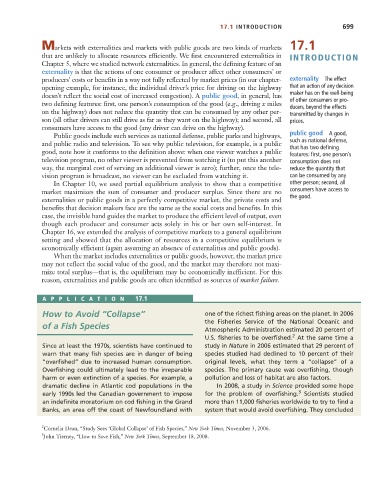Page 725 - Microeconomics, Fourth Edition
P. 725
c17ExternalitiesandPublicGoods.qxd 8/22/10 4:56 AM Page 699
17.1 INTRODUCTION 699
Markets with externalities and markets with public goods are two kinds of markets 17.1
that are unlikely to allocate resources efficiently. We first encountered externalities in INTRODUCTION
Chapter 5, where we studied network externalities. In general, the defining feature of an
externality is that the actions of one consumer or producer affect other consumers’ or
producers’ costs or benefits in a way not fully reflected by market prices (in our chapter- externality The effect
opening example, for instance, the individual driver’s price for driving on the highway that an action of any decision
doesn’t reflect the social cost of increased congestion). A public good, in general, has maker has on the well-being
of other consumers or pro-
two defining features: first, one person’s consumption of the good (e.g., driving x miles ducers, beyond the effects
on the highway) does not reduce the quantity that can be consumed by any other per- transmitted by changes in
son (all other drivers can still drive as far as they want on the highway); and second, all prices.
consumers have access to the good (any driver can drive on the highway).
Public goods include such services as national defense, public parks and highways, public good A good,
and public radio and television. To see why public television, for example, is a public such as national defense,
that has two defining
good, note how it conforms to the definition above: when one viewer watches a public features: first, one person’s
television program, no other viewer is prevented from watching it (to put this another consumption does not
way, the marginal cost of serving an additional viewer is zero); further, once the tele- reduce the quantity that
vision program is broadcast, no viewer can be excluded from watching it. can be consumed by any
In Chapter 10, we used partial equilibrium analysis to show that a competitive other person; second, all
market maximizes the sum of consumer and producer surplus. Since there are no consumers have access to
externalities or public goods in a perfectly competitive market, the private costs and the good.
benefits that decision makers face are the same as the social costs and benefits. In this
case, the invisible hand guides the market to produce the efficient level of output, even
though each producer and consumer acts solely in his or her own self-interest. In
Chapter 16, we extended the analysis of competitive markets to a general equilibrium
setting and showed that the allocation of resources in a competitive equilibrium is
economically efficient (again assuming an absence of externalities and public goods).
When the market includes externalities or public goods, however, the market price
may not reflect the social value of the good, and the market may therefore not maxi-
mize total surplus—that is, the equilibrium may be economically inefficient. For this
reason, externalities and public goods are often identified as sources of market failure.
APPLICA TION 17.1
How to Avoid “Collapse” one of the richest fishing areas on the planet. In 2006
the Fisheries Service of the National Oceanic and
of a Fish Species
Atmospheric Administration estimated 20 percent of
2
U.S. fisheries to be overfished. At the same time a
Since at least the 1970s, scientists have continued to study in Nature in 2006 estimated that 29 percent of
warn that many fish species are in danger of being species studied had declined to 10 percent of their
“overfished” due to increased human consumption. original levels, what they term a “collapse” of a
Overfishing could ultimately lead to the irreparable species. The primary cause was overfishing, though
harm or even extinction of a species. For example, a pollution and loss of habitat are also factors.
dramatic decline in Atlantic cod populations in the In 2008, a study in Science provided some hope
3
early 1990s led the Canadian government to impose for the problem of overfishing. Scientists studied
an indefinite moratorium on cod fishing in the Grand more than 11,000 fisheries worldwide to try to find a
Banks, an area off the coast of Newfoundland with system that would avoid overfishing. They concluded
2 Cornelia Dean, “Study Sees ‘Global Collapse’ of Fish Species,” New York Times, November 3, 2006.
3 John Tierney, “How to Save Fish,” New York Times, September 18, 2008.

